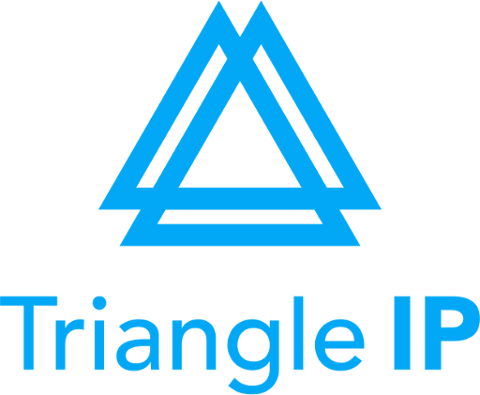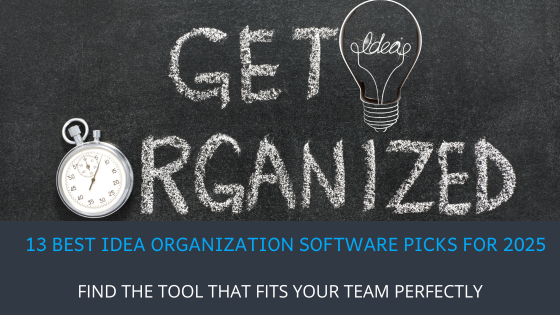How Much Does a Patent Cost in 2025? Avoid These Expensive Mistakes
| TL;DR:For SMEs, protecting innovation through patents requires balancing cost and strategy. This guide breaks down U.S. and international fees, attorney expenses, and hidden costs. It offers practical ways to predict patent costs and reduce unplanned spending, |
When patent applicants ask, “How much does a patent cost?” Most attorneys will often quote the price of the next step, which may be the cost of filing a patent or the cost of drafting.
That’s like building a house, but you’re only being quoted the price of the land. You can’t build a robust patent strategy based on such half-baked knowledge.
Filing is just the start. Then you need to pay to write the application, cover government fees, respond to rejections from the patent office, keep it alive with maintenance fees, and maybe even protect it overseas.
In Tom Franklin’s (a patent attorney of 25 years and the founder of Triangle IP) words: “Typically, it’s about the third of the cost goes to writing it (patent), a third of the cost goes to govt fees, and a third of the cost goes to arguing your patents.”
How to determine the cost of your patent? | Things to take care while going for patent filing
This guide will provide you with a further realistic breakdown of the costs, when they occur, and how to avoid wasting money on protection that may not actually provide the intended benefits.
How Much Does a Patent Cost: Understanding the Patent Process and Associated Costs
In the U.S., most patent applications begin with either a provisional or non-provisional application—two distinct approaches.
A provisional application locks in your filing date and gives you a 12-month window to decide if you want to move forward with a full patent. It’s budget-friendly: small enterprises often pay as little as $130 ($325 for large entities). That’s a small price to buy time and protect your idea early on.
But if you want the USPTO to actually review your invention and consider granting a patent, you’ll need to submit a non-provisional application within those 12 months. That’s the full, formal document with detailed claims and technical descriptions. It’s what triggers the official examination process and associated fees.
Before we discuss the breakdown of all the costs involved in detail, here is a quick breakdown:
| Fee Type | Micro Entity | Small Entity | Large Entity |
| Basic Filing Fee | $70 | $140 | $300 |
| Search Fee | $154 | $308 | $770 |
| Examination Fee | $176 | $352 | $880 |
| Excess Independent Claims Fee( excess 3) | $600 | $240 | $120 |
| Issue Fee | $258 | $516 | $1290 |
| Maintenance Fee (3.5 years) | $430 | $860 | $1250 |
| Patentability Search Cost | $1,500 – $4,000 | $1,500 – $4,000 | $1,500 – $4,000 |
| Drafting | $6,000 – $2,0000 | $6,000 – $2,0000 | $6,000 – $2,0000 |
| Prosecution Cost | $4,000 – $12,000 | $4,000 – $12,000 | $4,000 – $12,000 |
| PCT Application | $3,000 – $6,000 | $3,000 – $6,000 | $3,000 – $6,000 |
| National Phase Entry(EU) | $30,000 – $50,000 | $30,000 – $50,000 | $30,000 – $50,000 |
The USPTO Fee Schedule for 2025 just landed. Miss it, and you might miscalculate your entire IP budget.
Mandatory USPTO Official Fees Breakdown
When you file a patent with the USPTO, several fees apply right from the start. These cover the cost of reviewing, searching, and processing your application. They also help maintain your patent after it is granted.
Basic Filing Fee
This is the fee for submitting your application. It is $320 for large entities, $128 for small, and $64 for micro. It covers the administrative cost of setting up your file in the USPTO system.
Search Fee
The USPTO conducts a prior art search to check for similar inventions. It is to ensure that your idea is actually new and worth examining. Based on the latest USPTO fee schedule, the search fee is $700 for large entities, $280 for small entities, and $140 for micro entities.
Examination Fee
After the search, an examiner reviews your application in detail. That costs $800 for large entities, $320 for small entities, and $160 for micro entities. It’s what makes your patent real, as the examiner decides if it meets all legal standards.
Excess Claims Fee
If you have more than 20 total claims or more than three independent claims, you’ll pay extra. Each additional claim costs $100 (large), $50 (small), or $25 (micro). Extra independent claims cost $460, $230, or $115, respectively. It ensures applicants keep claims focused and avoid overloading the system.
Issue Fee
Once your patent is allowed, you must pay $1,000 (large), $500 (small), or $250 (micro) to get it granted.
It covers the formal publication and final processing of your patent rights.
Maintenance Fees
Due at 3.5, 7.5, and 11.5 years to keep your patent active. Large entities pay $1,600, $3,600, and $7,400. Small pay $800, $1,800, and $3,700. Micro pay $400, $900, and $1,850.Failing to pay for these means your patent rights will lapse and cannot be enforced.
| Claim: A claim in the USPTO patent process defines the legal scope and boundaries of the invention’s protection. It is a clear, concise statement describing the technical features of the invention that the applicant seeks to protect exclusively.A patent can have more than one claim. In fact, patents typically include multiple claims to cover different aspects or variations of the invention. |
Attorney and Professional Service Costs
The largest portion of your patent budget will typically go toward attorney fees. While it’s possible to file without professional help, the complexity of patent law and the significant value at stake usually make this unwise for business-critical innovations.
Patent Search Costs
Before filing a patent, start with a patentability search. This helps determine if your invention is likely to meet the legal standards of novelty and non-obviousness under 35 U.S.C. §§ 102 and 103. A search can prevent costly applications for ideas that are unlikely to be granted.
| Novelty: An invention is novel if it is genuinely new and has not been publicly disclosed or known before the patent application’s filing date. This includes prior patents, publications, public uses, or sales anywhere in the world.Non-obviousness: An invention is non-obvious if the differences between it and the prior art would not have been apparent to a “person of ordinary skill in the art” at the time of the invention. It ensures the invention isn’t just a trivial improvement or combination of existing knowledge. |
A professional search typically costs $1,500 to $4,000, depending on how complex or crowded the field is. Software, AI (Artificial Intelligence), and medical technologies usually fall on the higher end. Simpler mechanical inventions tend to be less expensive.
Pro Tip – Though it adds to your upfront costs, a search:
- Flags inventions unlikely to receive a patent.
- Helps craft stronger, more focused claims.
- Reveals competitor filings and trends.
- Guides you in refining your invention to avoid existing patents.
- Sets realistic expectations for you and your team.
You can begin with a DIY search using tools like Google Patents or the USPTO site. These searches, however, have limitations, especially with foreign patents or nuanced searches, and certainly not a replacement for a professional review.
Patent Drafting
Creating a strong patent application takes both legal skill and technical precision. Your patent must meet strict requirements under U.S. law, including those under 35 U.S.C. § 112, which demands a clear and complete written description(drafting). This is where quality has the biggest impact on how well your patent protects your invention. Therefore, drafting is expensive.
To give you an idea, attorney fees for drafting utility patent applications generally fall into the following ranges:
- Simple mechanical inventions: $6,000 to $9,000
- Moderately complex electrical or mechanical inventions: $9,000 to $14,000
- Complex software or biotechnology inventions: $14,000 to $20,000 or more
Note: As a patent attorney with 25 years of experience, Thomas advises everyone to ask a series of patent portfolio cost-related questions to their patent attorney. Feel free to listen to his thoughts here:
What should you ask your counsel about patent portfolio cost? | Thomas Franklin | Triangle IP
If you are filing a design patent, the costs are typically lower, ranging from $2,000 to $4,000. Design patents are shorter, have a simpler claim structure, and focus more on drawings than technical descriptions.
These costs reflect the time and expertise required to:
- Translate technical features into clear legal language
- Draft claims with the right scope to maximize protection
- Create supporting drawings that match the claims
- Anticipate likely rejections from the USPTO under statutes like § 101 (subject matter eligibility) or § 103 (obviousness)
- Structure the application to withstand scrutiny in litigation or licensing negotiations
If you do everything right in this stage, your patent will have comprehensive coverage, a solid technical and legal foundation, and strategic claims. Such patents are high-quality and often have a higher chance of getting approval.
Prosecution Costs
After you file your patent application, it enters prosecution, which is the back-and-forth process between your attorney and the USPTO. An examiner reviews your application and usually issues one or more Office Actions, which are formal rejections or objections. You and your attorney respond with legal arguments, claim amendments, or both.
Most applications receive two or more Office Actions before reaching a final decision. Each response typically costs between $2,000 and $4,000, depending on how complex the rejection is and how much legal or technical analysis is needed. Over the life of a typical case, you should budget $4,000 to $10,000 or more for prosecution alone.
These costs cover:
- Reviewing the examiner’s legal and technical arguments
- Drafting amendments to preserve the broadest claims possible
- Legal research to counter prior art or eligibility issues
- Interviews with the examiner to clarify misunderstandings
If you need more time to respond, you can certainly get an extension for a fee:
- One-month extension: $235/$94/$47
- Two-month extension: $680/$276/$132
- Three-month extension: $1590/$636/$318
- Four-month extension: $2495/$998/$499
- Five-month extension: $3395/$1358/$679
For small and medium enterprises, these costs can quickly increase. Therefore, to avoid surprises, build prosecution costs into your patent budget and plan well from the start.
International Patent Protection Costs
Patents are territorial—a US patent provides no protection in Europe, China, or elsewhere. International protection multiplies costs quickly, requiring careful strategy.
PCT Applications
If you want international patent protection but are not ready to file in multiple countries, the Patent Cooperation Treaty (PCT) offers a smart solution. By filing one PCT application, you preserve your U.S. filing date across more than 150 countries. This gives you time to test your invention’s market potential before committing to the much higher costs of foreign filings.
When filing a PCT application through the USPTO as the Receiving Office, you should budget for three main fee categories:
- Transmittal Fee (USPTO): $285 for large entities, $114 for small entities, and $57 for micro entities
- International Filing Fee: $1347 is the flat rate for all types of entities.
- Search Fee (USPTO as International Searching Authority): $2.400(large), $960 (small), or $480 (micro)
These fees do not include attorney costs, which typically range from $3,000 to $6,000 to prepare and file a well-drafted PCT application.
While these upfront costs are significant, the PCT process gives you up to 30 or 31 months from your earliest filing date to decide where to file nationally.
National Phase Entry
Once the PCT phase ends, you must decide where to pursue patent protection through national or regional patent offices. This is one of the most financially significant points in your IP strategy, as costs increase quickly with each country you choose.
For every country you enter, expect to pay:
- Translation costs: around $2,000 to $3,000 per language, especially for jurisdictions like China, Japan, or Europe
- National filing fees: typically $200 to $1,000
- Local attorney fees: around $2,000 to $5,000 to prepare and file each national entry
- Ongoing maintenance fees: vary by jurisdiction and increase over time
To put this in perspective, obtaining a European patent through a grant can cost between $30,000 and $50,000. Similar figures apply to other major markets such as China, Japan, and Korea. Filing in multiple jurisdictions can easily exceed six figures.
Because of this, you should approach national phase entry with a selective, strategy-driven mindset. Focus on countries where:
- You plan to sell or distribute your products
- Your competitors manufacture or operate
- Patent enforcement is reliable and cost-effective
- The region holds strategic licensing or partnership opportunities
For most small to mid-sized enterprises, targeting 3 to 5 key markets offers the best return on investment. The real value of the PCT system is not just in deferring these costs, but in giving you time to gather the data on markets, competitors, and partners.
Hidden and Unexpected Costs
Filing and issuance are only part of the cost. Many companies underestimate the additional expenses that come up as a patent moves through prosecution, enforcement, and beyond. If you are building a serious IP strategy, these costs should be on your radar.
Office Action Responses
Most utility patent applications receive two to three Office Actions. Responding to each can cost $2,000 to $4,000, depending on complexity. If you need more time, USPTO extension fees may add hundreds of dollars per deadline.
Continuation Applications
You might file one or more continuations to pursue additional claims or adapt your IP to evolving business needs. Each continuation comes with new filing, examination, and attorney fees, often repeating the original cost cycle.
Enforcement and Monitoring
Owning a patent is not enough. You need to monitor for potential infringement and be ready to act. In that process, you may have to speed on the following:
- Patent monitoring services: $1,000 to $3,000 per year
- Cease-and-desist letters: $1,000 to $2,000 each
- Litigation reserves: Patent lawsuits can range from $300,000 to over $3 million, depending on the venue and complexity
Opportunity Costs
Your technical and executive teams may spend hours reviewing drafts, supporting responses, or working with counsel. That is time not spent on product development or business growth. These soft costs are harder to measure but are real, especially for resource-limited teams.
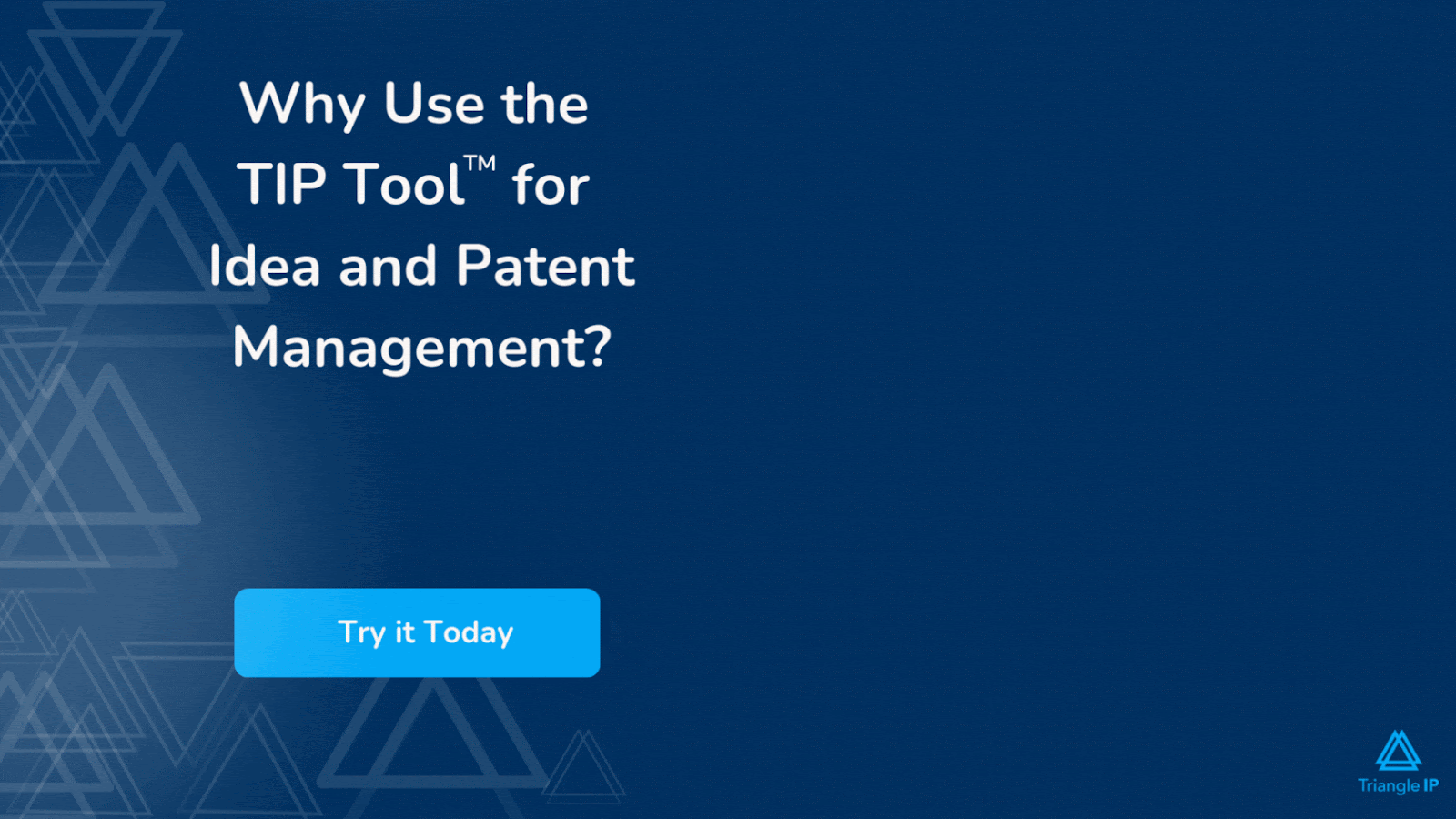
Use Triangle IP’s The TIP ToolTM to Predict Costs
If you’re running innovation at a small or mid-sized enterprise, you already know that patents are expensive. Filing fees are set by the USPTO, and attorneys follow standard billing structures. But what often gets overlooked is how early procedural choices like claim language, filing strategy, and art unit targeting significantly influence downstream costs.
The TIP Tool™ helps applicants take control of these early variables, streamlining prosecution and improving cost efficiency across the USPTO lifecycle.
Steer Away from Difficult Art Units
Every non-provisional application gets assigned to an art unit based on its subject matter and claim language. Some art units, like Class 705, are known for high rejection rates under 35 U.S.C. §101 (subject matter eligibility) and §103 (obviousness).
Getting routed to one of these can result in multiple office actions, Requests for Continued Examination (RCEs), and ballooning legal costs. The thing is that most SMEs don’t realize this routing is influenced by how claims are written — until it’s too late.
The TIP Tool™ Advantage
The TIP Tool™ predicts likely art unit assignments before you file using its Art Unit Predictor. It flags high-risk units early and suggests how claim phrasing could lead to a different, more favorable classification. This insight helps your attorney avoid problematic units from the outset and reduce the chance of excessive office actions or prolonged prosecution.
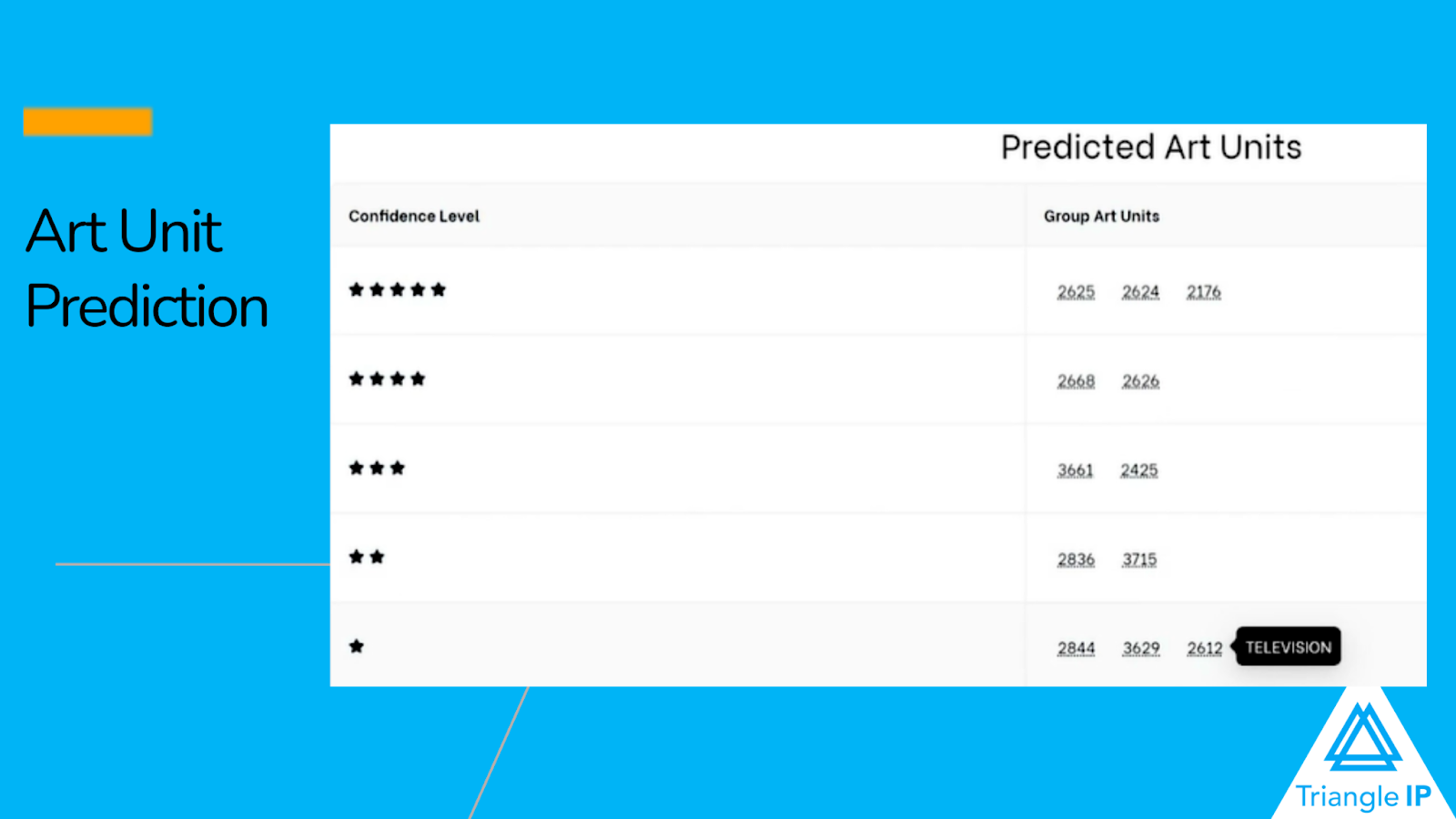
Understand Your Examiner and Calibrate Your Strategy
After the art unit assignment, your application lands in the hands of an individual examiner who can make or break your prosecution budget. Some examiners lean heavily on §101 rejections or issue early final rejections, while others show a higher allowance rate when interviews are conducted.
For an SME, this can be the difference between an efficient approval and a long, expensive back-and-forth. Knowing who your examiner is and how they typically behave lets you adapt your strategy.
The TIP Tool™ Advantage
The TIP Tool™’s Examiner Analysis feature gives you a full profile: allowance rates, rejection patterns, average time to allowance, appeal cycles, appeal decisions, and briefs. With this, you can decide whether to pursue early interviews, file continuation strategies, or tailor amendments based on data.
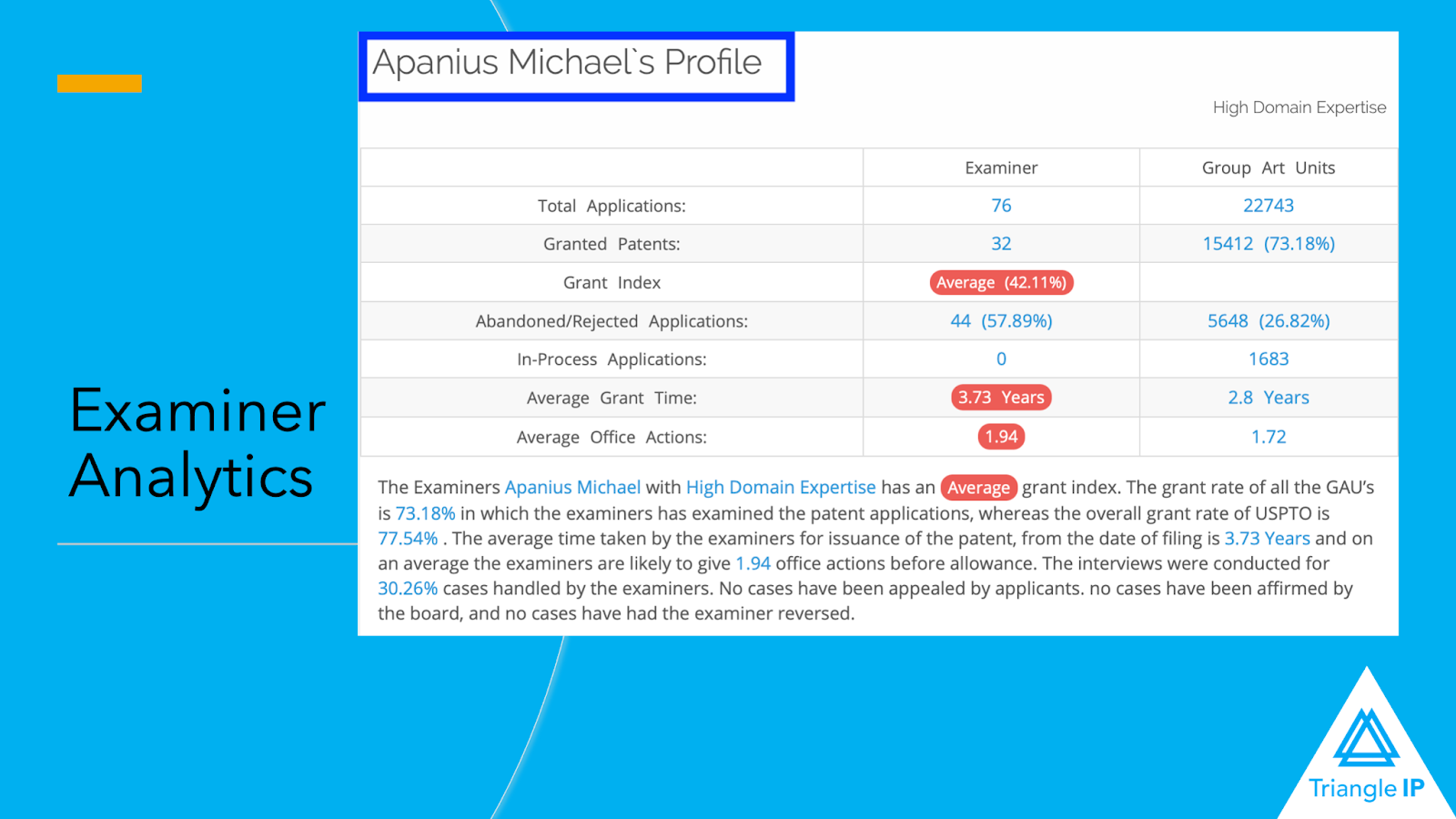
Have a Comprehensive View of Your Patent Cost to Wisely Plan IP Budget
Patent filings are not one-time events. Costs accumulate at every stage: filing fees , excess claims, RCEs, issue fees , and post-grant maintenance fees. The problem is, it’s not as straightforward as just asking your patent attorney and keep aside money for the next payment. Unless you are doing a lot of work with your council, it’s hard to know the exact due amount, especially when unexpected items surface, like USPTO notices requiring formal drawings, requests for information (RFIs), or examiner objections that trigger additional attorney responses.
“I would say if you are spending less than a hundred thousand dollars, it’s really hard to say what it’s going to be”– in Thomas’s words, at least $100k worth of involvement gets you an accurate monthly prediction.
How can companies forecast their patent portfolio cost? | Thomas Franklin | Triangle IP
One solution is to carefully review your patent files to have a clue and plan accordingly. However, the TIP Tool™ offers an easier alternative.
The TIP Tool™ Advantage
The TIP Tool™ gives you real-time, USPTO-synced cost estimates for every asset in your portfolio. Click on a patent, and you’ll see a breakdown across prosecution stages — including drafting, argument rounds, RCEs, and maintenance.
This data comes from two sources: 1) For USPTO fees and other government fees, the algorithm fetches data from the official sources and shows estimates based on the average number of rounds. 2) user inputs, such as a flat fee charged by the patent council.
By combining these sources, it accurately predicts future costs that closely match reality.
Such critical information not only prevents bad financial surprises but also empowers you to make key strategic decisions, such as whether to pursue or abandon specific patents.
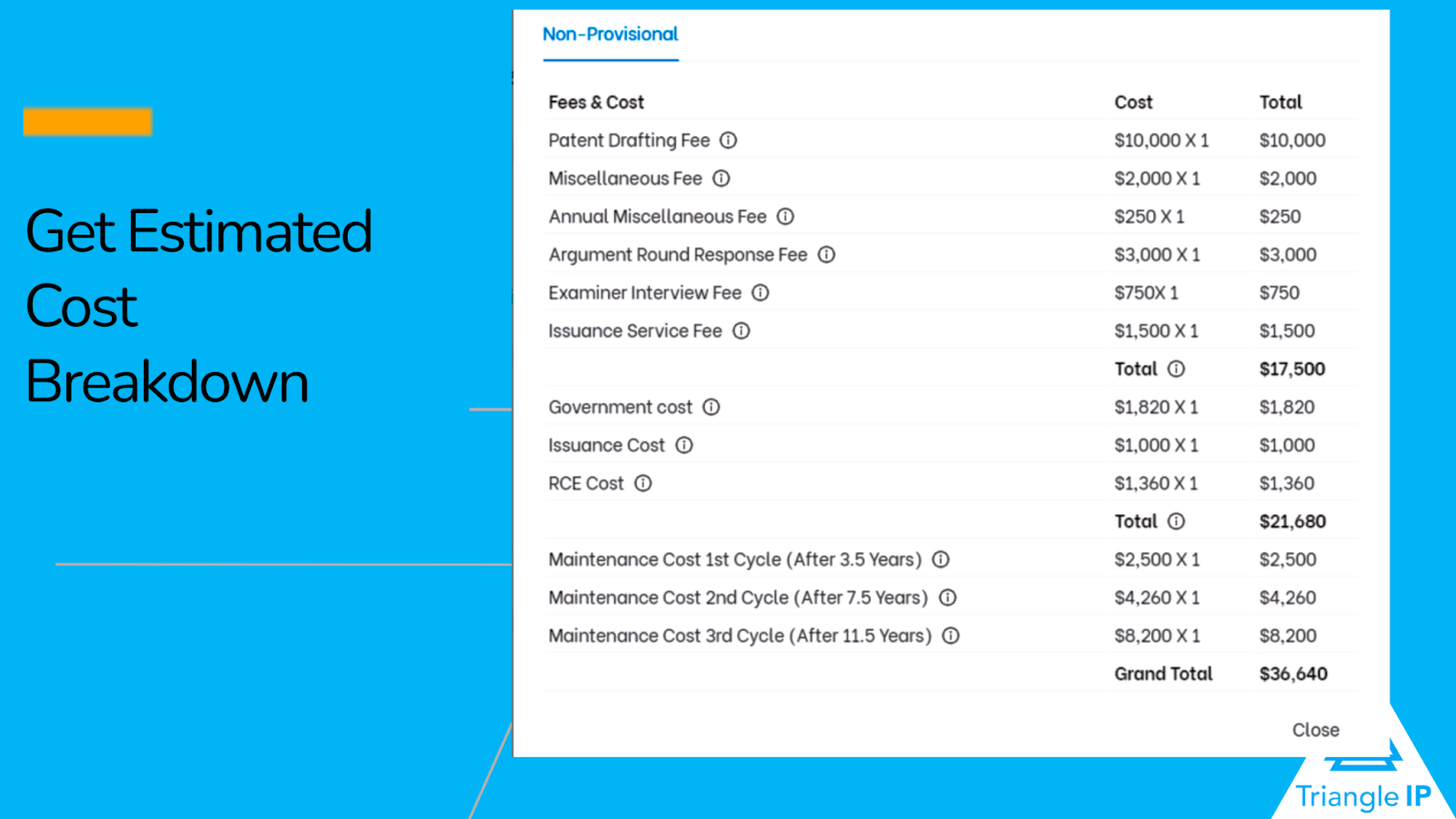
Apart from these, the TIP Tool™ also offers other crucial features, such as idea tracking, art unit prediction, and submission management, to give SMEs a data-driven edge in efficiently managing their IP portfolio.
If you are evaluating tools, here are the 5 Top Enterprise Innovation Software to Checkout in 2025

The TIP Tool™ offers a forever-free plan. Feel free to sign up here to give it a go.
FAQ
What’s the Best Way to Manage Patent Costs Within an SME’s Limited Budget?
SMEs can manage patent costs effectively by treating intellectual property (IP) as a strategic portfolio investment. This involves allocating part of the R&D budget to patents, prioritizing high-impact innovations, and funding applications in stages based on market progress. Setting ROI thresholds for maintenance and reinvesting licensing revenue helps sustain the portfolio, while working with IP counsel attuned to SME needs ensures cost-effective decisions.
Do I Lose Anything by Starting with a Provisional Patent Instead of a Full Utility Application?
No, you don’t lose protection if the provisional is well-prepared. But it gives no legal rights until you convert it to a utility application. If the provisional lacks technical detail or support for later claims, you might lose priority. So don’t treat it casually. Use it strategically, but treat it like a real filing.
What Happens If I Can’t Afford to Pay Maintenance Fees Later On?
Your patent will lapse permanently, and you can’t get it back. You’ll lose enforcement rights, even if the technology is still valuable. If budgets are tight, review your portfolio every year. Drop patents with little return and keep the ones protecting key revenue or licensing potential.
Should I Always Get International Protection for My Invention?
Only file abroad if you plan to sell, license, or block competitors in that market. For some products, U.S. protection is enough. Use the PCT to buy time. Then narrow your filings to 3–5 countries with the highest commercial relevance.
For more information, you can watch this video where Thomas ( Founder of Tringle IP) shared when and how to approach international protection.
Right time to create a Global Patent Portfolio Strategy
Can Trade Secrets and Patents Work Together, or Do I Have to Choose?
You can patent the core invention and keep the surrounding know-how as trade secrets. For example, patent the software architecture but keep the training data or optimization methods confidential. Just make sure what you keep secret isn’t disclosed in your patent.
